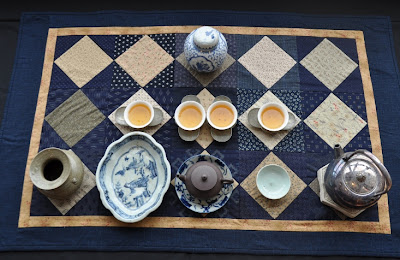Cultivar: Luanze/qingxin Oolong
Origin: Lugu, Dong Ding (central Taiwan)
Elevation: 700 meters
Harvested by hand on April 17th, 2013
Process: Hung Shui Oolong (charcoal roasted)
This tea is what remains of a batch that was submitted to the Lugu towniship farmer's association (=Dong Ding Oolong tea) competition of this spring 2013. This is the biggest and most renowned Oolong competition in Taiwan: around 5000 lots compete for the top prizes in spring and winter. Thanks to the success of this event, similar tea competitions have been created all around the island to help promote local teas. An important factor to consider is the number of participants. A high number creates more competition for quality.
This competition dates back to the early 1980s. At first, the farmers were suspicious of this government interference with their trade. Who were these judges to think they could rank their teas? So, in one of the first competitions, the farmers submitted twice the same batch of tea to the competition, under 2 different names. They wanted to test the judges and see if the same tea would receive different grades. Instead, the judges were able to taste the similarity between the 2 lots and told the farmers that the same tea had be submitted twice! This proved the seriousness and professionalism of the judges. These are employed by the Tea Research and Extension Station (TRES), Taiwan's tea research institute.
Now that the TRES had gained the trust of the Dong Ding farmers, it would wield influence over the taste of competition Dong Ding Oolong. The director of the TRES had learned his tea skills in Wu Yi (Fujian) and that's why his judges favored roasted Oolongs that were similar to Wu Yi Oolongs. And to this day, the characteristic of this competition Dong Ding Oolong is its strong Yancha-like roasting.This is why we find a distinctive Wu Yi suan (acidity) in this Dong Ding Oolong.
20% of the grade comes from the appearance of the tea leaves. Thus, the farmers remove the stems before submitting the tea to the competition. The impact on the tea is more concentrated aromas, because stems are not very fragrant. On the other hand, this increases a little bit the cost of the tea and you loose the sweet taste of the stems.
The leaves smell nutty, musty with dark malt and bitter chocolate notes. Beyond these darker fragrances, I can still smell a fresh Oolong note. The fragrance is complex, but harmonious. The brew's notes are rounder and blend well one with another. (Fragrances count for 30% of the grade).
The brew's color and clarity counts for 10%. We can see an appealing golden color that lacks turbidity.
With 40%, the taste carries the most weight in the Dong Ding competition. This batch is very close to what you expect from a top grade Dong Ding Oolong. The roasting is powerful and mixes well with the underlying tea. There are no defects and the mouth feels clean when you swallow your brew. It is a tea that feels very alive. The Wu Yi suan acidity provides like a strong structure for the taste to develop in the mouth until the back. It tickles the tastebuds and makes me salivate. This sweet/sour taste becomes more and more sweet as the time goes by. The throat remains open and the aftertaste goes on and on. A late freshness appears on the tongue. Excellent!
Subscribe to:
Post Comments (Atom)













No comments:
Post a Comment